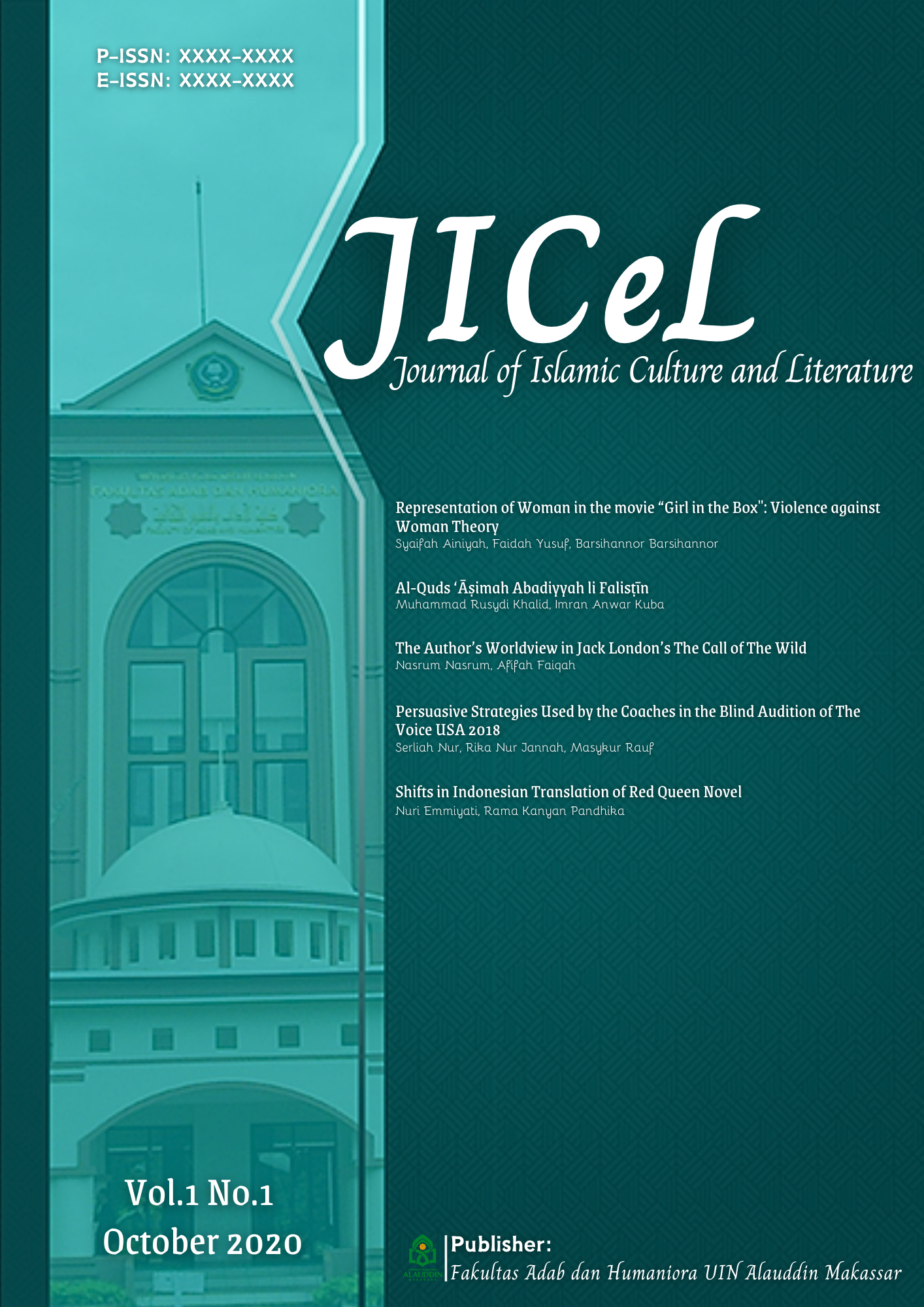Persuasive Strategies Used by the Coaches in the Blind Audition of The Voice USA 2018
Abstract
This article discusses the persuasive strategies used by the coaches in the blind audition of The Voice USA 2018. The objects of this research are the utterances of the four coaches in The Voice USA 2018 who are Adam Levine, Alicia Keys, Kelly Clarkson, and Blake Shelton. The objectives of this research are to identify the kinds of persuasive strategies and to analyze the way the persuasive strategies were expressed by the coaches in the blind audition of The Voice USA 2018. This research used a descriptive qualitative method. The data sources in this research are videos and transcripts. The researcher took twelve videos of the blind audition of the Voice USA 2018 which have more than three million views on YouTube as the sources of data. The researcher took the data from the official YouTube account of The Voice. In collecting the data, the researcher watched all the twelve videos of the blind audition of The Voice USA 2018 from the official YouTube account of The Voice and transcribed the videos. The instrument that is used in this research is the researcher herself as the instrument to get the data. The results of the research show that the four coaches in the blind audition of The Voice USA 2018 used three persuasive strategies which are logos, ethos, and pathos. The way of the coaches used the three strategies was different. When stating logos, the coaches persuaded the contestants by stating logical reasons, a specific fact, and truths as a piece of supporting evidence. When they used ethos, they showed their reputation, credibility, image, character, and the previous record to get more trust from the contestants. Then, when they used pathos, they used emotional appeal to control the contestants' emotions.
Keywords: Logos, Phatos, Ethos, Blind Audition
References
Aditama, M. G. (2016). Persuasion in International Journals: Pragmatic Analysis. Universitas Muhammadiyah Surakarta.
Argyropoulou, V., & Ypsilantis, G. S. (2017). Persuasive Strategies in Argumentative/Persuasive Discourse Written in Italian by Greek Second Language Learners. Paper presented at the 19th Annual Conference of the English Department of the University of Bucharest, Romania. http://ikee. lib. auth. gr/record/289014/files/GRI-2017-19167. pdf (15.9. 2019).
Aristotle. (1967). The Art of Rhetoric (J. H. Fressy & W. Heinemann, Trans.). London: Ltd. London.
Bettinghaus, E. P., & Cody, M. J. (1994). Persuasive communication: New York, US: Holt, Rinehart and Winston, 1987.
Burke, K. (1969). A rhetoric of motives: Univ of California Press.
Cline, A. R. (2002). Understand and Act: Classical Rhetoric, Speech Acts, and the Teaching of Critical Democratic Participation. Department of English and Department of Political Science. University of ….
Cockcroft, R. (2004). Putting Aristotle to the proof: Style, substance and the EPL group. Language and Literature, 13(3), 195-215.
Diamond, G. A., & Cobb, M. D. (1996). The candidate as a catastrophe: Latitude theory and the problems of political persuasion. Political persuasion and attitude change, 225-247.
Hardin, K. (2001). Pragmatics of persuasive discourse in Spanish television advertising. Word: Journal of the International Linguistic Association, 56(2), 288-291.
Huckabee, S. (2018). Ethos, Logos, Pathos. Retrieved 10th July 2019, from https://huckabeeclassroom.com/ethos-logos-pathos.html
Leech, G. N. (1966). English in advertising: A linguistic study of advertising in Great Britain: Longmans.
Mukarromah, N. (2016). Persuasive strategies used in slogan of IPhone advertisements. Universitas Islam Negeri Maulana Malik Ibrahim.
Nothstine, W. (1989). Influencing others a handbook of persuasive strategies: Crisp Learning.
Perloff, R. M. (2003). The dynamics of persuasion: Communication and attitudes in the twenty-first century: Routledge.
Poggi, I. (2005). The goals of persuasion. Pragmatics & Cognition, 13(2), 297-335.
Rank, H. (1988). Persuasion Analysis: A Companion to Composition: ERIC.
Authors who publish with this journal agree to the following terms:
1) Authors retain copyright and grant the journal right of first publication with the work simultaneously licensed under a Creative Commons Attribution License that allows others to share the work with an acknowledgement of the work's authorship and initial publication in this journal.
2) Authors are able to enter into separate, additional contractual arrangements for the non-exclusive distribution of the journal's published version of the work (e.g., post it to an institutional repository or publish it in a book), with an acknowledgement of its initial publication in this journal.
3)Authors are permitted and encouraged to post their work online (e.g., in institutional repositories or on their website) prior to and during the submission process, as it can lead to productive exchanges, as well as earlier and greater citation of published work (See The Effect of Open Access).


